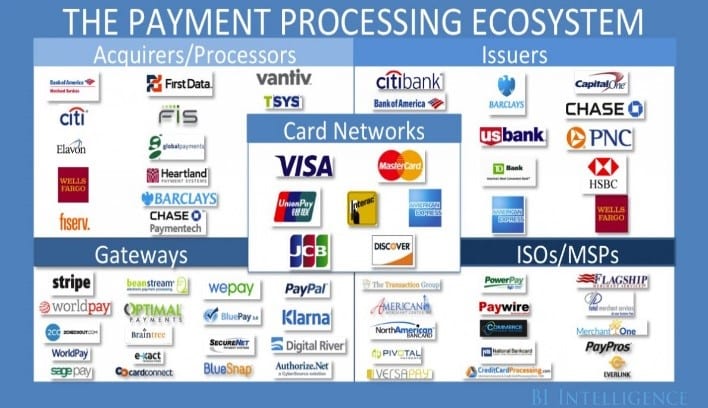There first step to lowering your credit card merchant fees is to understand how the credit card processing ecosystem works, the players in the credit card processing industry, and understanding which part of the ecosystem you can approach to lower your credit card merchant fees.
Having this information helps you alleviate wasted time approaching providers that make no sense to negotiate with. This is a crucial step that will help you alleviate and lower credit card merchant fees in the long run.
Payment Industry Ecosystem
There is a lot that goes behind the scenes when a business accepts a credit card from it’s customers. All within a split second, a customer’s credit card information and data is processed through multiple different operating channels and it’s important to understand how all of them work.
What is a Credit Card Merchant Account?
A credit card merchant account is essentially a line of credit that allows a business to accept credit cards from its customers as form of payment. Pretty straight forward. The reason a credit card merchant account is considered a line of credit is because a business gets paid before any money is truly collected from the business’s customer, similar to a short term loan.
Similar to how a checking account works, a credit card merchant account allows a business to accept a payment, except instead of check or direct deposit, they allow credit card transactions. However, a credit card merchant account does not hold the money but instead has a customer’s payment pass through the credit card merchant account and deposited into the business owner’s bank account after the transaction has been approved (typically within 24-48 hours.)
What a lot people do not understand about the credit card merchant industry is that the big players (Visa, MasterCard, Discover) do not provider credit card merchant accounts what so ever. Instead, they rely on credit card merchant processors, ISO’s (Independent Sales Organizations), banks, and independent credit card merchant agents, to sell, market, and service businesses.
American Express, which we all know and love (wink wink), operationally has a different set up than the other 3 card networks. Amex has its own merchant accounts and a business would need to set up directly through them if they wanted to accept their cards. Here is the catch however: If you process less than $1M / year in American Express, a business can sign up for their OptBlue Program (mentioned in further detail throughout this article), which allows re-sellers to set businesses up with American Express instead of going through them directly. See the difference between American Express OpBlue and American Express direct Here!

Card Issuer: The issuing bank, or card issuer, is the entity that creates the piece of plastic to be processed by merchants. These are your Bank of America debit or credit cards, Chase “Sapphire” credit cards, Capital One, and the list goes on. Go into your wallet and take out your credit or debit card. The name of the bank or entity on the card is what we call the Card Issuer.
Card Network: There are only so many networks but the 4 main credit card processing networks most would recognize are VISA, MasterCard, Discover, and American Express. Others include UnionPay, JCB, Maestro, Interlink, STAR, SHAZAM, NYCE, Accel, Plus, Interact (Canadian), Visa ReadyLink, and Pulse. Picture these as imaginary telephone wires that transfer your credit and debit card data around the ecosystem.
Merchant: The business itself is considered a merchant. Whether the business a sole proprietor, LLC, Partnership, C-Corp, or S Corp, they are a nonetheless a merchant.
Acquirer: The acquiring bank is YOUR bank. Your bank will collect the data from the credit card transaction when you buy a good or service.
Credit Card Processor/ISO/Merchant Account Provider: These are the guys, or ladies, who make this industry oh so colorful to the say the least. They get the most recognition, and they are the cause of all those phone calls your business receives on a daily basis telling you they can save you money. They are the Third Party, the middleman, that process the credit card transactions a business performs on any given day.
From here, there are also Direct Processors and then there are ISO’s (Independent Sales Organizations). There is one major difference between both and that is an ISO can essentially sell credit card processing for as many Direct Processors as it wants. There then comes into play Registered ISO’s and then there are Unregistered ISO’s. The major difference between those two is that an Unregistered ISO is just a sales agent. You know, one of the guys, or ladies, who walk into a business and try to sell you credit card processing. A Registered ISO is an actual independent company.
Some examples of Direct Processors are:
- First Data, now Fiserv
- Worldpay, now FIS
- TSYS
- Global Payments
- Paya
- Paysafe
- ChasePaymentTech
- Elavon
- American Express
- Heartland, now Global
Some examples of ISO’s are:
- CardConnect
- Vantiv
- Bank of America
- Wells Fargo
- Citibank
- Suntrust Bank
- BB&T
- Santander
- Moneris
- Cayan, now TSYS
- Merchant E Solutions
- IPayment
- North American Bancard
- Leaders Merchant Services
- Merchant Lynx
- Intgreity
- EvO
- Sterling Payment Technologies
- BlueSnap
- Fatt Merchant
- Payment Depot
- Host Merchant Services
- Payment Cloud
Gateways: These are strictly for online businesses only. They allow your customers to “Pay Now” on your website, collect the credit card processing information, encrypt the data, and sends an authorization request to the card issuing bank through the Direct Processor or ISO.
Some examples of credit card merchant gateways:
- Authorize.net
- Braintree
- PayPal – PayFlow
- Stripe
- CardPointe
- USAePay
- PayEazy
- WePay
- BlueSnap
- PaySimple
- PayTrace
Payment Facilitator (PayFacs): PayFacs are the Square, Stripe, PayPal, and Braintree’s of the world. These guys, or ladies, offer credit card processing on a sub – merchant platform.The main difference between a PayFac and a Direct Credit Card Processor is they are a bit more efficient when offering their services and the underwriting is performed on an on going basis as opposed to right upfront like you see with a Direct Credit Card Processor.
Continuing to understand the landscape of credit card merchant fees and the credit card processing ecosystem are crucial to making sure your business received the best deal possible when looking for a provider or negotiating your current agreement.
